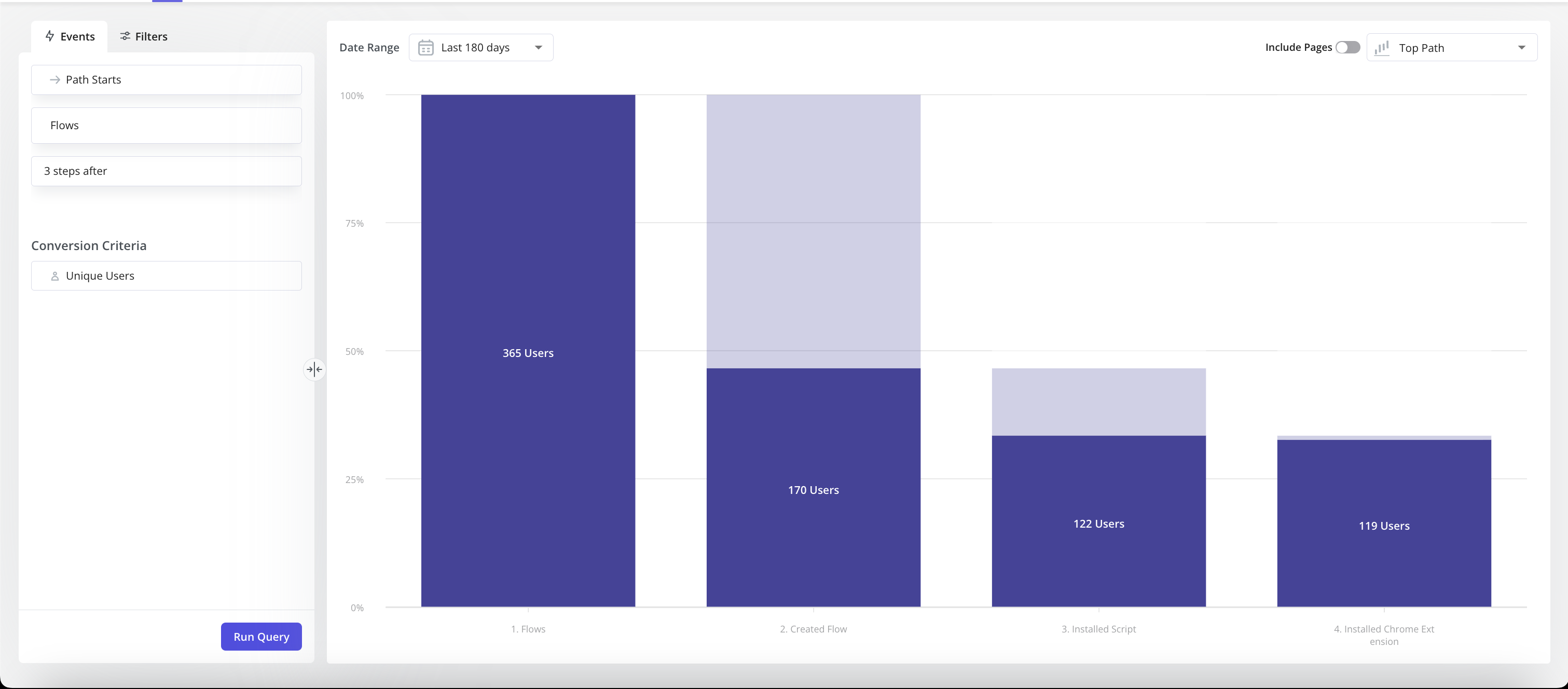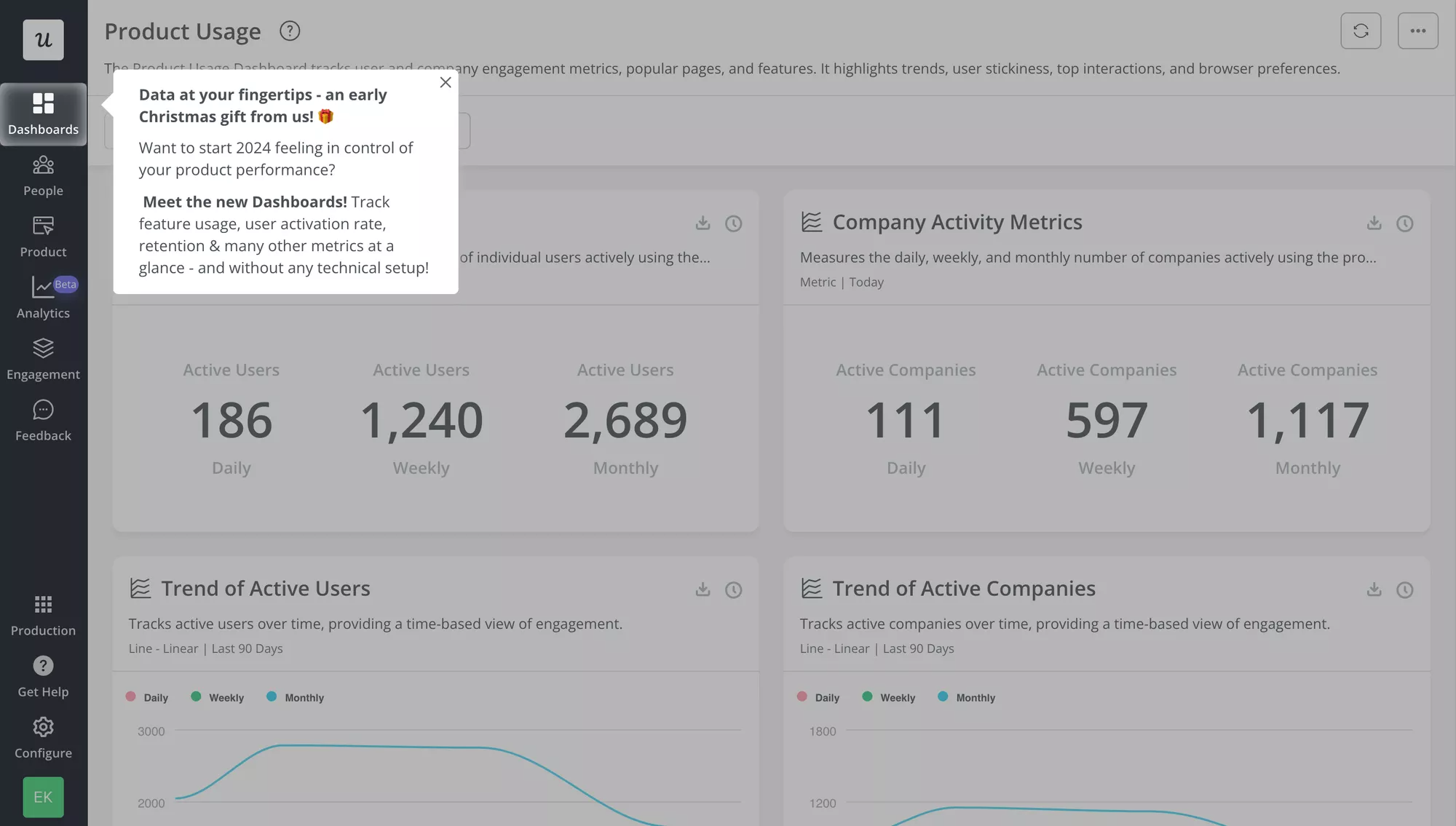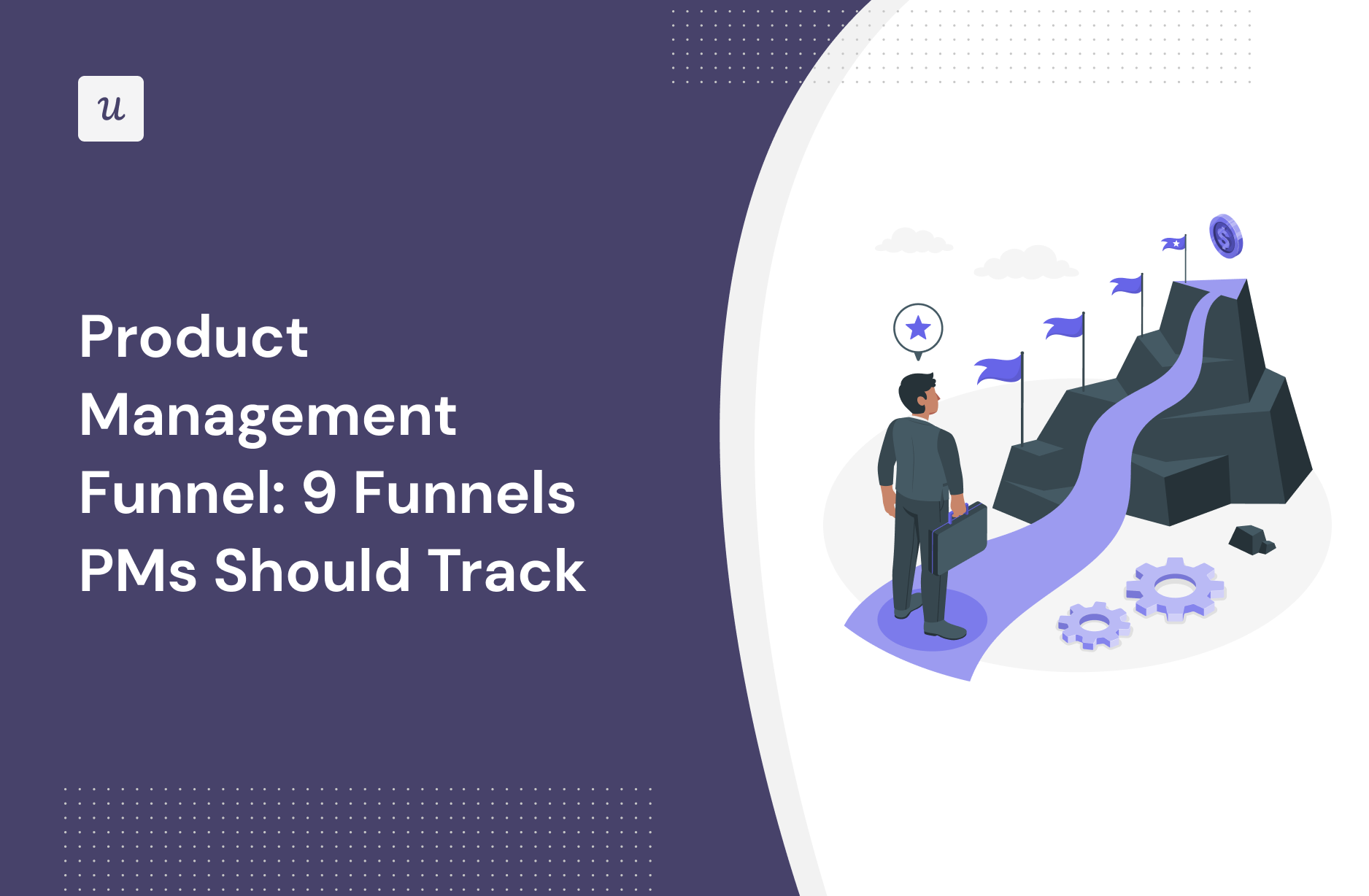
What is a product management funnel? What is the difference between the PM funnel and the sales funnel, and why is the sales funnel important? What are the different funnels that PMs should track? And why do they matter?
If you’re after the answers to these questions, you’re in luck, because that’s exactly what we explore in our article. We also look at how you can harness the power of analytics tools to optimize your funnels.
Ready to dive in?
Try Userpilot Now
See Why 1,000+ Teams Choose Userpilot

Summary of product management funnel
- The product management funnel, also known as the conversion funnel, is a powerful tool for tracking and optimizing user journeys.
- Sales and marketing teams use the product management funnel and sales funnel interchangeably.
- It allows teams to better understand user needs to make data-driven product decisions and identify friction that results in users dropping off from the customer journeys.
- The sign-up funnel consists of the steps necessary for users to access the product, starting from account creation.
- The user activation funnel is made up of the actions users need to complete to realize product value.
- The new feature adoption funnel is about driving new feature discovery and engagement.
- The steps necessary to upgrade to a paid or higher plan make up the upgrade funnel.
- Retention funnel analysis focuses on the users who drop off at different stages of the journey.
- The churn funnel, also known as the cancellation funnel, tracks the steps before the users leave the product for good.
- The reactivation funnel consists of the steps needed to re-activate users. For example, sending them limited-time promotional offers.
- To optimize your funnels, track the behavior of power users to identify happy paths. Then, track how other users progress and look for bottlenecks.
- To see how you can optimize product management funnels with Userpilot, book the demo!
What is a product management funnel?
Product management funnel is a term that is used in two ways.
The less common use of the term is linked to the product management process. It describes the stages that the product goes through, like ideation, product roadmap development, or MVP release.
More frequently, the term is used about conversion funnels.
Conversion funnels illustrate the stages of different customer journeys that users take, starting from awareness and finishing with a specific action. For example, if their goal is signing up for the product, it’s all the steps the user needs to complete to achieve it.
In this article, we’re focusing on the various conversion funnels that product managers should track.
Product management funnel vs sales funnel management
The Product Management Funnel and the sales funnel management process are quite different within a business, each with its objectives, stakeholders, and metrics.
The Product Management Funnel primarily focuses on the development, marketing automation, and lifecycle management of products, involving activities such as market research, feature prioritization, and iteration based on user feedback. The ultimate goal is to create valuable products that meet customer needs and drive long-term growth.
In contrast, the sales funnel stages are centered around customer acquisition and revenue generation. It encompasses activities such as lead generation, marketing campaigns, and sales pitches, to convert potential customers and qualified leads into paying customers and maximizing revenue.
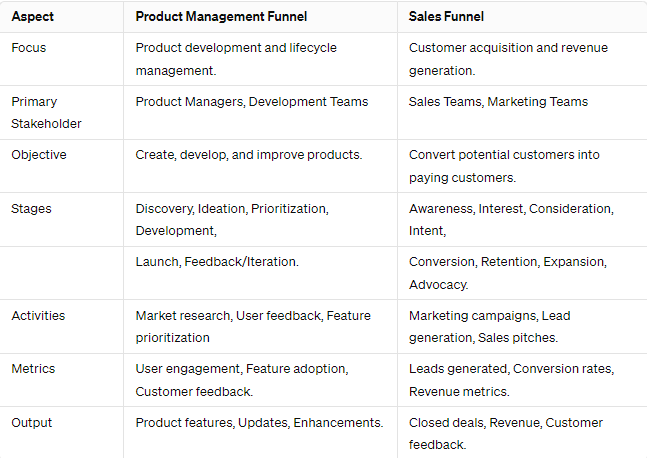
While the Product Management Funnel and the Sales Funnel serve different purposes, they are interconnected, as a well-designed product can facilitate the sales process, and effective sales efforts can drive adoption and growth for the product.
Collaboration between the product management team, sales reps, and marketing teams is essential to ensure alignment and maximize success across both sales funnels.
Different stages of a SaaS funnel
These stages collectively form the AARRR framework which is commonly used by SaaS companies to analyze and optimize their growth strategies throughout the marketing funnel and customer lifecycle.
Each stage represents a critical milestone in the journey from acquiring users to generating revenue and building a sustainable and successful SaaS business.
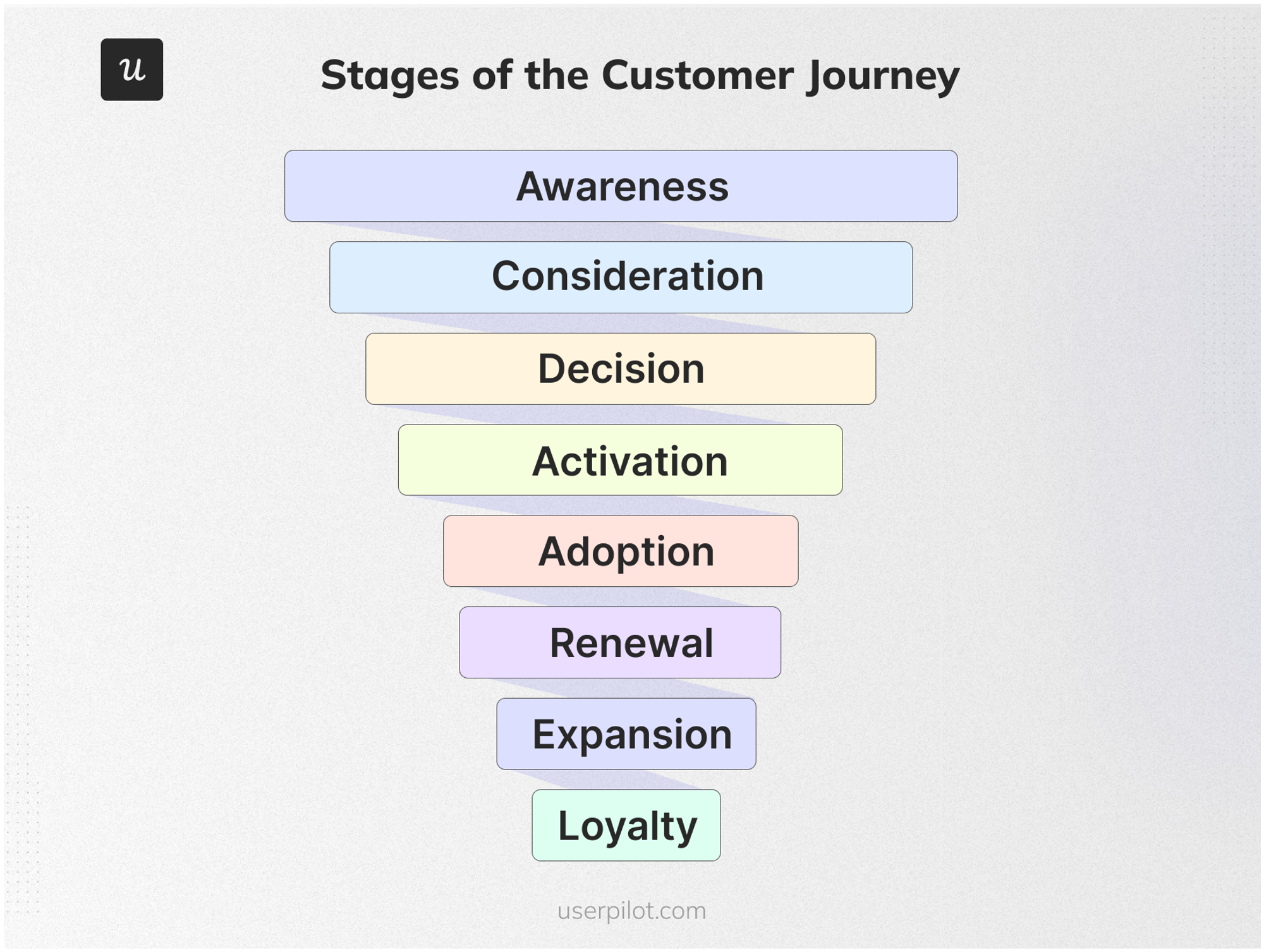
Here’s a breakdown of each stage:
- Awareness stage: This is the stage where potential users or customers first discover your SaaS product. It involves attracting traffic to your website or app through various marketing channels such as SEO, content marketing, social media, paid advertising, or referrals.
- Activation: Activation refers to the process of converting new customers into active users by getting them to take the desired initial action within your product. This action could be signing up for an account, completing a profile, or starting a trial. The goal is to provide a smooth onboarding experience that demonstrates the value of your product early on.
- Adoption: Once users have activated their accounts, the focus shifts to encouraging them to fully adopt and integrate your SaaS product into their workflows or daily routines. This involves guiding users through the key features and functionalities of your product and providing tutorials, training resources, and support to help them become power users.
- Retention: Retention is about keeping users engaged and satisfied with your SaaS product over time. It involves delivering ongoing value, addressing user needs and concerns, providing excellent customer support, and proactively preventing churn. The goal is to build long-term relationships with users and reduce customer churn rates.
- Referral: Referral refers to the stage where satisfied users advocate for your SaaS product and refer it to others in their network. This can happen through word-of-mouth, social sharing, or referral programs. Encouraging referrals can be an effective way to acquire new users at a lower cost and with higher trust.
- Revenue: Revenue is the ultimate goal of the SaaS funnel. It involves converting active users into paying customers or increasing the revenue generated from existing customers through upsells, cross-sells, or subscription upgrades. Maximizing revenue requires optimizing pricing strategies, providing value-added services, and continuously improving the product to meet evolving user needs.
Why is funnel management important?
There are several reasons why tracking conversion funnels is an essential part of a product manager’s job.
Firstly, funnel tracking helps product managers understand user needs and pain points. By monitoring and analyzing how users interact with the product at different stages of the journey, it’s easier to make informed product development and prioritization decisions.
Secondly, tracking conversion funnels enables PMs to identify friction and drop-off points in the user journey. By addressing them, they can optimize the journey and customer experience. This could translate into higher activation, adoption, or trial/freemium-to-premium conversion rates.
Finally, a product manager can use conversion funnel analysis to track the product’s overall performance and make forecasts. For example, if they know the current conversion rates, they can predict future revenue based on the number of new sign-ups.
Overall, funnel analysis insights guide the work of sales team,the product team and the marketing, customer success, and engineering teams.
9 Conversion funnels PMs should monitor
Now that we know what conversion funnels are, let’s look at 9 examples that might interest product managers and product owners.
For each of them, we start by mentioning its overall goals and then, dissecting its stages.
Sign-up funnel
The goal of the sign-up funnel is to get new leads and potential customers into the product as quickly as possible. That’s because the sooner they start experiencing its value, the more likely they’re to remain your users and convert into paying customers later down the line.
To achieve this, you need to remove all the unnecessary steps from the process because they create friction.
Let’s look at how Wordtune Read has built a frictionless sign-up flow.
First, a new user needs to create an account. Wordtune offers the single sign-on (SSO) option so that users can log in using their existing Google, Apple, or Facebook accounts. The option to register with an email is there too but that requires extra effort.

Next, Wordtune asks users about their general goals. Do they need it for work, studies, or pleasure? This is to personalize their user experience.
The next question is even more specific. It asks for the kind of text the user wants to summarize. This is to further customize the product to their needs.
Finally, users get to submit the doc they want to summarize. There are 3 ways to do it, and users can choose the one that fits their workflow best (Wordtune does the rest).
Free-to-paid conversion funnel
Monitoring the Free-to-Paid Conversion Funnel is crucial for Product Managers (PMs) in SaaS companies as it directly impacts revenue generation and business growth. Here’s a breakdown of the steps within this conversion funnel that PMs should closely monitor:
- Free Sign-up/Registration
- Activation
- Engagement and Feature Adoption
- Value Demonstration
- Upgrade Decision
- Payment/Conversion
- Post-Conversion Experience
- Retention and Churn
- Expansion and Upselling
User activation funnel
Here’s SkedSocial’s onboarding funnel.
The process starts with a modal that prompts users to add their first social media account – that’s kind of essential for a social media management tool.
Users can do it themselves or with the help of one of their customer success managers.
Adding the account triggers a checklist, which is a powerful way to onboard users. It consists of 4 steps, including creating the account, which they’ve already done.
The next funnel stage involves creating their first social media post.
The flow finishes with a congratulatory message which rewards users for getting across the finish line.
New feature launch adoption funnel
This adoption funnel aims to help users discover the new feature and start using it to reach their goals.
When you launch a new feature, make sure that users find out about it.
When Userpilot launched its newly overhauled survey functionality, the team made an in-app announcement via the modal below.
It briefly introduced the feature and highlighted its key benefits. Most importantly, it included a CTA prompting users to try it out.
Clicking on the CTA button takes users to the Surveys dashboard where a sequence of tooltips takes them through the process of creating surveys, step-by-step.
This reduces the time users would otherwise need to figure out how to use the functionality by themselves.
Account expansion funnel
Ever heard of cross-sells or up-sells?
They’re both used in the context of the upgrade conversion funnel.
The goal of this funnel is account expansion by converting from free to paying customers or to a higher plan. This helps SaaS companies maximize their revenue by increasing customer lifetime value (CLV).
Let’s see how Canva drives up-sells.
The product offers both free and premium designs. Clicking on a premium design triggers a contextual modal prompting the user to upgrade their pricing plan.
Even though Canva offers a 30-day trial, it still wants you to commit to the purchase, so they first ask you if you want to pay monthly or annually.
At the next funnel stage, you need to provide your payment details. Only when they do that, they can start enjoying the premium features.
Retention funnel
The retention funnel tracks users as they drop off from the customer journey.
So if your customer journey consists of five steps, the funnel analysis will reveal how many users from each cohort completed each step, and how long it took them. More importantly, it will show you how many users never progressed and churned.
Places with the biggest drop-off are where you need to look for bottlenecks and friction points to optimize the journey.
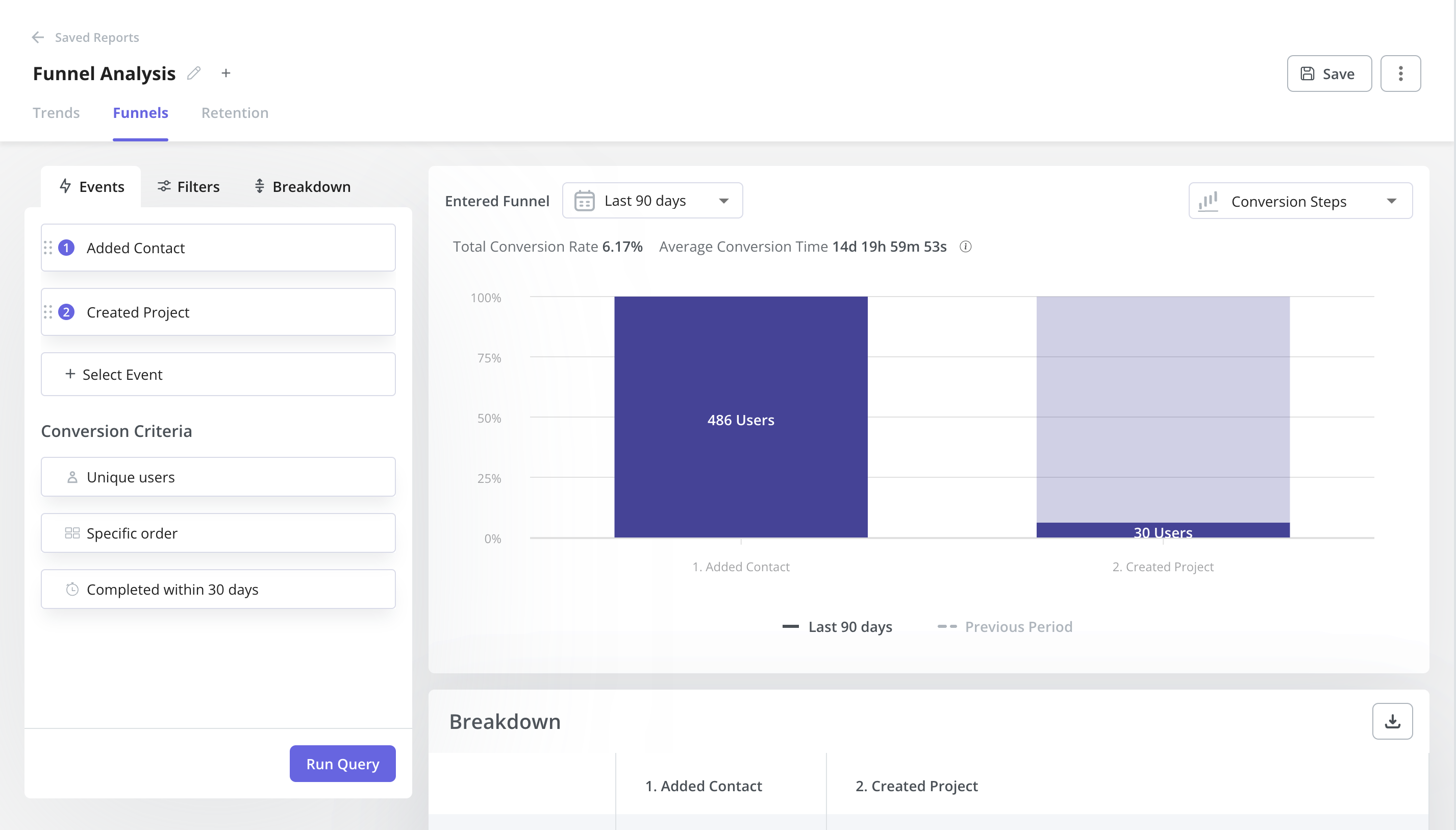
For example, you can contextually trigger in-app messages relevant to their use case to encourage engagement and retain more customers.
Cancellation funnel
The churn funnel is, in other words, the cancellation funnel. It describes the steps users take when they decide to cancel their subscriptions.
To reduce churn, companies don’t make it easy for users to cancel. This is because it’s the last chance to engage users before they’re gone for good.
That’s why it’s a common feature to trigger a churn survey which gives you insights into why they decided to leave. That’s what Zoom does.
It’s normally followed by the final bid to retain the user, for example by offering them a more attractive pricing plan.
Reactivation funnel
Reactivation funnels are the opposite of churn or cancellation funnels. It describes the steps your users take when they re-subscribe.
We normally use it in the context of reengaging inactive or churned users.
Let’s imagine you cancel your LinkedIn Premium subscription.
An email arrives in your mailbox acknowledging the cancellation.
After which another email is sent that contains a limited-time offer just in case you’re ready to reconsider.
How product managers can optimize funnels with analytics
Let’s check out how you can use a product analytics tool to optimize your funnel. The steps below will work regardless of whether you’re trying to optimize the free trial conversion rate or retention rate.
Step 1: Identify the ideal happy path for each funnel
Start by identifying the happy path – this is the optimal path through your funnel.
How can you do it?
Track how power users engage with the product. They’re the most successful and loyal users, so analyzing their product usage can offer you insights into what works and what does not.
Step 2: Optimize each funnel stage with in-app messages
Once you find the issues, eliminate them.
How?
Depends on the product and the funnel you’re optimizing.
You may need to adjust your pricing tiers, remove unnecessary steps from the flow, or simplify product pages. To push users along the happy path and offer guidance, you can trigger in-app messages.
Conclusion
In summary, the Product Management Funnel guides product managers through the stages of product development, focusing on delivering value and driving growth.
It differs from the Sales Funnel management strategy, which concentrates on customer acquisition and revenue generation. While their objectives vary, both funnels are interconnected, and optimizing them is crucial for business success.
By tracking and refining conversion funnels, product managers can enhance user experiences and drive business growth effectively. Book Userpilot to track in-app conversion funnels.




















